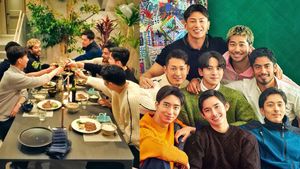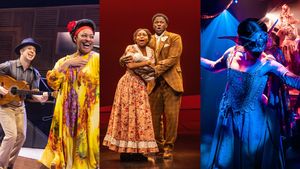For years, much of the case for LGBT rights has been based on the argument that sexual orientation is fixed and immutable -- baby, we were born this way, and it's wrong to discriminate against us for something we didn't choose.
But an increasing body of social science research posits that a sizable number of people experience some degree of fluidity in their sexual and romantic attractions: being drawn to the same gender at one point in their life, the opposite gender at another. Researchers emphasize that this is not something that can be imposed from without, as "ex-gay" therapy would attempt to do, but something that occurs from within. Although our supporters already recognize that why we love who we love is irrelevant, embracing fluid orientations may call for a new approach in advocating for our rights.
The research to date indicates that fluidity is more common among women than among men, but scientists note that this could change as studies continue. Reliable data has only emerged in recent years, but there are now several studies that have found that 10 to 14 percent of American women describe themselves as mostly, but not completely heterosexual, and 6 to 9 percent of American men who self-identify the same way, says Lisa Diamond, a professor of psychology and gender studies at the University of Utah. Studies in other countries have found the same general range, she says.
"It's far more common to be someone who is a little bit attracted to the same sex than someone who is exclusively attracted to the same sex," says Diamond, author of the 2008 book Sexual Fluidity: Understanding Women's Love and Desire.
If you consider the people who might be mostly gay or lesbian, but at some point attracted are to the opposite gender, the total number of people with a fluid sexuality will be significantly greater, says Ritch Savin-Williams, a professor of developmental psychology at Cornell University. While there has been less study of this population, "I wouldn't want to constrain sexual fluidity only to 'mostly straight,'" he says.
Neither Diamond, who is lesbian, nor Savin-Williams, who is gay, was initially looking for fluidity when they began their research. Diamond noticed in the early 1990s that most of the research done on adult sexual identities was on men. "So my feminist instincts kicked in, and I just went into it trying to put women back into the picture," she says. In an open-ended study, she notes, "What I found, almost right away, was a really surprising amount of movement in women's identities."
Savin-Williams has been doing research on sexual minority youth for about 30 years, and he found that many young people expressed some qualifications about their sexual identity. And the term bisexuality "doesn't quite capture a lot of what the young people were feeling," he says. For instance, he encountered young men who might say, "I'm really attracted to women, but I wouldn't rule out the possibility of a guy," he notes.
The idea that not everyone is exclusively attracted to one gender, or equally and constistently attracted to both, isn't exactly new. Groundbreaking sexuality researcher Alfred Kinsey and his colleagues developed the Kinsey Scale in 1948, placing sexuality on a continuum of 0 to 6, "exclusively heterosexual" to "exclusively homosexual."
Further research has recognized even more variability. Fritz Klein, the doctor who founded the American Institute of Bisexuality, released the Klein Grid in 1978, which analyzes seven aspects of sexual orientation in people's past, present, and ideal lives, for 21 possible combinations. And a recent study by Savin-Williams asked young adults to report their sexual orientation on a nine-point scale. In a report of his findings to be published soon in The Journal of Sex Research, he concludes that "heterosexual, bisexual, and gay/lesbian individuals do not constitute the universe of sexual orientations."
But for whatever reason -- the desire to organize everything into neat, discrete classifications, or the need to band together to advocate for equal rights -- the world tends to operate on the assumption that these four identities do indeed comprise the full universe of sexual orientations. But the recognition that there is more variability and the possibility of change over time, however, need not undermine the case for equal rights.
"It should not matter how we got this way," says Diamond, who has seen her research misused by antigay activists, such as opponents of marriage equality. "Either we are a society that protects people's rights to sexual expression, to how we choose our families, or we're not."
She notes that those defending the so-called Defense of Marriage Act attempted to use her research in their cause and nonetheless lost their case. "It doesn't matter why we love who we love," she says. In June 2013, the U.S. Supreme Court agreed.
Nor do findings on fluidity validate "ex-gay" therapy, which has been widely repudiated by mental health professionals. The fact that people can have a fluid sexuality shouldn't be confused "with the idea that change means being heterosexual in perpetuity," says Meredith Chivers, an associate professor of psychology at Queen's University in Canada.
"It doesn't mean we can necessarily corral women's sexuality into one form of expression," continues Chivers, who came to the study of fluidity through research on sexual response patterns in women. "Sexual variability is who we are as human beings."
"Sexual fluidity is not about somehow choosing one's desires or identities, in the way that the antigay opposition has portrayed gayness," says Leila J. Rupp, a professor of feminist studies at the University of California, Santa Barbara. "We do think that there is a better argument to be made for LGBT rights: namely, that sexual desires and behaviors and identities may not always align and they may change over time, but they do not change lightly, in the same ways, as [New York University professor] Lisa Duggan has argued, that religious identities are not something that change on a whim, although they do change."
Rupp is one of the authors of a study, "Queer Women in the Hookup Culture: Beyond the Closet?" that will be published in the April issue of the journal Gender & Sexuality. Her study found that the college hookup culture, generally characterized as heterosexual, is, for some women, a setting "to explore and to later verify bisexual, lesbian, or queer sexual identities."
"Some students are embracing fluid identities and calling themselves 'queer,' 'pansexual,' 'fluid,' 'bi-curious,' or simply refusing any kind of label," says study coauthor Verta Taylor, a UCSB professor of sociology and Rupp's life partner. "The old label bisexual no longer fits, because even that term implies that there are only two options: lesbian/gay or straight."
To some people, of course, "bisexual" is not an "old label." Diamond says that based on her research, being bisexual is distinct from being fluid, although the life paths taken by bisexual people and those with a fluid sexuality may similar. Bisexual people, says Diamond, experience a stable state of being attracted to both sexes, while those who are fluid see their attractions change over time. But, like bisexuals, people with a fluid sexuality may be with a partner of the same sex at one point in their life, a partner of the opposite sex at another.
Some see a definite relationship between fluidity and bisexuality, however. "I see bisexuality and fluidity as definitely linked," says Ellyn Ruthstrom, president of the Boston-based Bisexuality Resource Center. Fluidity is easy for bisexuals to understand, she says, as "people are attracted to people, not just genders, and it can happen in different ways at different points in life."
"I think that fluidity is simply a way to express the gray area that reality really is," says Denise Penn, a member of the board of directors for the American Institute of Bisexuality. "I think that fluidity is a way of talking about bisexuality. ... Fluidity, in reality, refers to a range, and I think that's good."
While Faith Cheltenham, president of BiNet USA, says that "as a black woman who's bisexual, I'm going to identify with the communities that I know are going to assist me," she and her colleagues at BiNet have long embraced those who claim a fluid identity. BiNet's website describes the group as "America's umbrella organization and voice for bisexual, pansexual, fluid, queer-identified and all other of us 'somewhere in between' people." In 1999, while a student at the University of California, Los Angeles, Cheltenham founded an organization to represent those people, one of the first of its kind -- it was called Fluid.
She also points to a 1990 document, "The Bisexual Manifesto," from the Bay Area Bisexual Network, which reads in part, "Bisexuality is a whole, fluid identity. Do not assume that bisexuality is binary or duogamous in nature: that we have 'two' sides or that we must be involved simultaneously with both genders to be fulfilled human beings. In fact, don't assume that there are only two genders."
Bisexuality has often been maligned, both by anti-LGBT forces who believe bisexuals are necessarily nonmonogamous, and by some gays and lesbians who consider bisexuality merely a stage on the way to a gay or lesbian identity -- or perhaps denial of such an identity. Bisexuals continue to suffer substantial discrimination and abuse, notes Cheltenham, who was one of the organizers of last September's White House roundtable on bisexual issues.
But there are positive developments, such as numerous celebrities claiming a bisexual identity, Cheltenham says. She also thinks greater awareness and acceptance of sexual fluidity is "absolutely" good for bisexual visibility and empowerment.
It appears that such awareness and acceptance will continue to increase. Diamond and Savin-Williams, for instance, say that among younger people, there is greater willingness to acknowledge a fluid identity than among their elders. "I think it's the kind of culture we live in that gives young people the option," says Savin-Williams.
And while Diamond started with studying women, she is now studying sexual fluidity in men. "I have been amazed by how much fluidity and variability men report as well," she says. In another decade, the research may show a much larger number of men in the "fluid" category, she says.
These developments are good for the LGBT movement in general, say the researchers and activists. "I think that all research is good," says Penn, adding, "It's beneficial for the movement to count everybody as part of our group."
Savin-Williams concurs. "I think we all fight for the same thing," he says, noting that people who identify as mostly straight but fluid, for example, are as progressive about sexual diversity as LGBT people, and are "natural allies" in the fight for equal rights. "Our umbrella," he concludes, "has become bigger."




































































Charlie Kirk DID say stoning gay people was the 'perfect law' — and these other heinous quotes